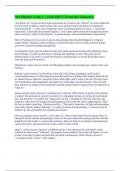Exam (elaborations)
Art History Unit 1 || with 100% Errorless Answers.
- Course
- Institution
"Academic Art" correct answers State-sanctioned art created in the "official" art style established by the French Academy, which looks to the art of ancient Greece and Rome for inspiration. Characterized by: 1. crisp, clear renderings with a convincing illusion of space. 2. statuesque, naturalistic...
[Show more]



